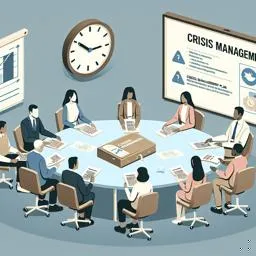In the realm of Public Relations (PR), the ability to effectively manage a crisis is an indispensable skill. During a crisis, an organization's reputation and future can hinge on how well it communicates with stakeholders. This communication must be swift, transparent, and strategic to mitigate damage and rebuild trust. Understanding the intricacies of stakeholder communication during a crisis can transform a potentially disastrous situation into an opportunity for growth and strengthened relationships.
At the heart of crisis management in PR is the need to maintain trust and credibility. Stakeholders, including customers, employees, investors, partners, and the general public, expect timely and accurate information. They need to know how the crisis affects them and what steps are being taken to resolve it. Therefore, the cornerstone of effective crisis communication is the development of a comprehensive crisis communication plan well before any crisis occurs.
A crisis communication plan should outline the key messages, designate spokespersons, and establish protocols for internal and external communication. It should also include a list of key stakeholders and preferred communication channels for each group. The plan must be flexible enough to adapt to different types of crises, whether they are product recalls, data breaches, natural disasters, or executive scandals.
During a crisis, the first step is to assess the situation swiftly. This involves gathering all available information to understand the scope and potential impact of the crisis. With this understanding, the organization can formulate its key messages. These messages should be clear, concise, and consistent, focusing on the facts and the steps being taken to address the crisis. Transparency is crucial; stakeholders need to feel that the organization is being honest and forthcoming.
Once the key messages are crafted, it's essential to communicate them through the appropriate channels. Different stakeholders may prefer different modes of communication. For instance, employees might be best reached through internal emails or meetings, while the public might respond better to social media updates or press releases. Utilizing multiple channels ensures that the message reaches a broad audience and caters to different preferences.
The role of a spokesperson is critical during a crisis. This individual should be well-trained and prepared to handle media inquiries, press conferences, and other public appearances. The spokesperson must embody the organization's values and convey empathy and confidence. They should be able to answer questions honestly, admit when they don't have all the answers, and commit to providing updates as more information becomes available.
In addition to external communication, internal communication is equally important. Employees are ambassadors of the organization and can influence public perception. Keeping them informed and engaged helps maintain morale and ensures that they can answer questions from customers and clients accurately. Regular updates and open lines of communication can prevent misinformation and rumors from spreading within the organization.
Social media plays a pivotal role in crisis communication. It offers a platform for real-time updates and direct engagement with stakeholders. However, it also presents challenges, such as the rapid spread of misinformation. Organizations must monitor social media channels closely during a crisis and be prepared to correct false information quickly. Engaging with stakeholders on social media shows responsiveness and a commitment to transparency.
Throughout the crisis, it is vital to listen to stakeholders. Feedback can provide valuable insights into how the crisis is perceived and what concerns need to be addressed. Surveys, social media monitoring, and direct communication can all be used to gather feedback. This information can guide the organization's response and help refine its communication strategy.
Once the immediate crisis has been addressed, the focus should shift to recovery and learning. This involves evaluating the effectiveness of the crisis communication plan and identifying areas for improvement. Conducting a post-crisis analysis can provide lessons that strengthen future crisis responses. It is also an opportunity to rebuild trust and relationships with stakeholders through continued engagement and demonstration of lessons learned.
In conclusion, effective stakeholder communication during a crisis is a complex but essential component of PR. It requires preparation, clear messaging, strategic use of communication channels, and a commitment to transparency and empathy. By mastering these elements, organizations can navigate crises more effectively, preserving their reputation and fostering stronger relationships with their stakeholders.








